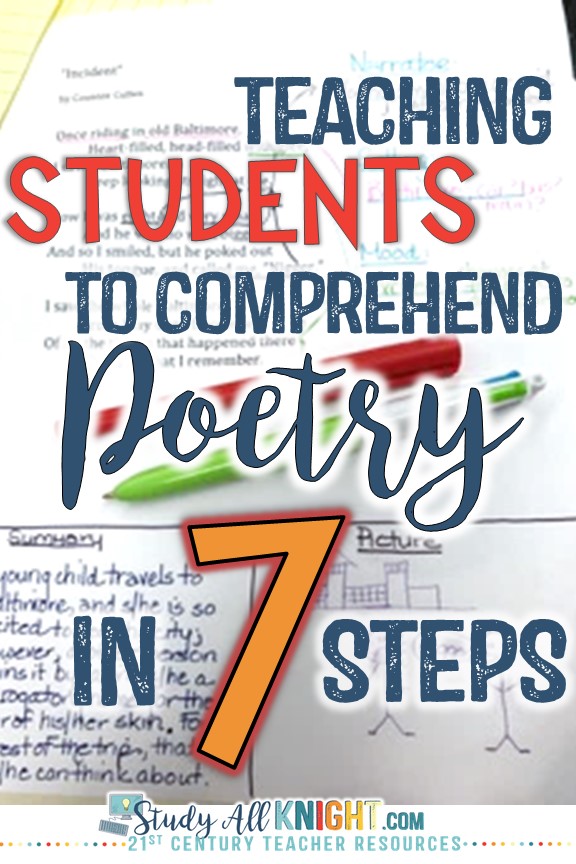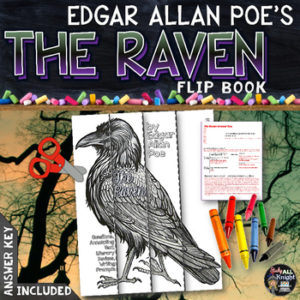Today I am excited to welcome Kim from English Oh My as our guest blogger. She has some great ideas for teaching students to comprehend poetry in a manageable way. Enjoy!

Happy April, and Happy National Poetry Month! Poetry is a timeless genre, and it is a part of most English Language curriculum. When I tell my students they are going to learn, read or write poetry, a chorus of growls, grunts, and eye rolls follows the introduction. No matter how a teacher introduces the aspects of poetry, no matter how many handstands, cartwheels and balancing acts we do to try to make poetry fun and engaging, it is just not enough to get our students to buy into learning about and reading poetry. That’s why today’s post is about teaching students to comprehend poetry in a manageable way.
Many students tend to resist poetry because “they just do not understand it.” In general, our students have a difficult time finding the theme and main idea in ANY literature, and when a text is shortened to a few stanzas, this task becomes even more challenging.
I wanted to share with you some very helpful strategies one of my professors shared with the class when I was studying British Literature in college. I have never forgotten his tips, and I have adapted them into my own classroom to assist my students with the comprehension of a poem and make the poetry journey, well, a little less grueling.
My grade eight students are currently in the middle of reading To Kill a Mockingbird and, throughout the book, I try to introduce a variety of media, texts, music and poetry to differentiate the learning experience, as well as help my students appreciate different parts of the novel.
Step # 1: Setup the Poem
Before my class read this poem, I had my students complete a “Poem Setup”. In the blank space to the right, I had my students write the following words: narrator, setting, and mood. You can have your students write this anywhere on the page, as some teachers like their students to annotate while they read in the marginal space provided.
At the bottom of the page, I had my students draw two boxes: one for a summary and one for a picture. See the picture below:
Step # 2: Always Read a Poem Twice!
I always reiterate to my students they will never understand a poem in one read. They need to read it twice, sometimes even a third time, and even then, they may not comprehend the poem completely.
Following the page setup, I read the poem aloud the first time, and then I had my students silently read the second time.
Step # 3: Use Investigative Skills & Identify the Narrator or Speaker of the Poem
One thing I stress to my students is the speaker of the poem is NOT always the poet speaking. Sometimes, they have to look at the narrator/speaker like a character in a book. The quicker your students recognize the narrator/speaker, the faster it will help them understand the context of the poem.
When we read the poem, I articulated to my students to think about the questions, “Who is telling the event/s of the poem, and how do you know?” With this, I expressed that they need to show evidence in the poem where it revealed the narrator/speaker. Underlining key words or words shows evidence of their thinking.
Step # 4: Identify the Setting
Identifying a setting gives a reader visualization and imagery to the context of any literature. The reader begins to form pictures in his/her mind of what is happening in the piece due to the time and place.
After my students identified the speaker, I asked them to find and identify the setting. To show evidence of the setting, they needed to underline it in the poem, and then write it under or next to setting. In addition, they were also asked to try to identify “where” and “when” the poem was taking place, and then try to specify if it takes place in the past, present or future.
Step #5: Identify the Mood
With any piece of literature, I find it very important for a reader to identify how a character is feeling. This has the reader empathize and connect to a character or person. Feeling for another causes the reader develop an appreciation for the character/person’s actions and behaviors, as well as understand why s/he is acting and speaking a particular way.
Therefore, I then asked my students, “Is the narrator excited, scared, thrilled, or terrified? How is the narrator/speaker feeling throughout the poem?” I instructed them to identify the mood in the poem, and I stressed that a mood can change over the course of a piece.
Step #6: Summarize the Poem
Summarizing the poem in one’s own words is a great way to show an understanding of a poem. Normally my rule of thumb is a summary should not be more than 25 words, and when writing a summary, the should be able to identify the “who, what, where, why, when and how” of the poem.
In the bottom left hand side of the poem, I instructed my students to write the events of the poem in their own words.
Step # 7: Put the Poem in Action by Drawing a Picture
If your students have a difficult time summarizing the poem, have them try to put the poem in action by drawing a picture of what they believe is happening. For some students, visualization is essential for comprehension.
I had my students both summarize and draw the picture of the events.
All in all, when you take a look at the final product of the seven steps, there is quite a bit of visual comprehension on the page-notes, arrows, evidence, drawings, etc. This shows teaching students to comprehend poetry is possible!
In the future, I hope these seven steps will strengthen your students’ skills with the comprehension of a poem.
***You do not have to replace these strategies with the skills you teach your students in analyzing poetry. These strategies can be added to other skills and techniques you review and teach (i.e. figurative language, vocabulary and structure). ***
If you would like a copy of the poem “Incident”, you can access it here. You may want to use this poem in your classroom, and it has many important themes that tie into character, integrity, and racism.
~~~~~~~~~~~~~~~~~~~~~~~~~
About Kim: I am a middle school English teacher on Long Island, NY. I have been teaching for 17 years, and I absolutely love teaching middle school. My passion is to ignite a love of reading, writing and to strengthen my students’ integrity and confidence as an English student, as well as a student who will make a difference in the world. Please follow me in the following ways: Teachers Pay Teachers, Blog, Facebook, Instagram, or Pinterest.
Here are some poetry and To Kill A Mockingbird resources you’ll love for your students:









5 Comments
Thank You.
Poetry sounds like a good thing to do
Now I know more about poetry and the things inside of it
I like how these books would be more knowledge of poetry
Hi! I m a middle school teacher taking grade 6 and 7. Thanks so much for the beautiful explanation on how to teach poetry in the middle school. I realize I m already following in class!